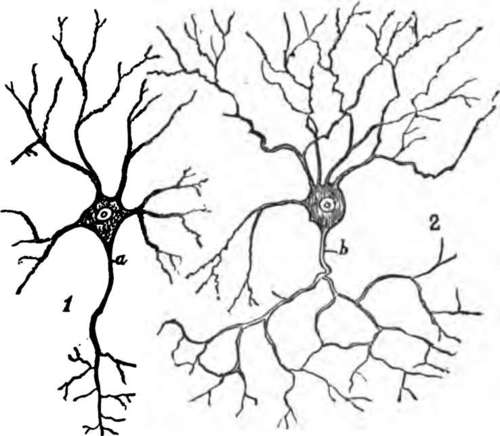Nerve Cells
Description
This section is from the book "The Human Body: An Elementary Text-Book Of Anatomy, Physiology, And Hygiene", by H. Newell Martin. Also available from Amazon: The Human Body.
Nerve Cells
As far as our knowledge at present goes, all nerve-fibres begin as branches of nerve-cells.
At 1, Fig. 87, is shown a nerve-cell such as may be found in the anterior part of the gray matter of the spinal cord. It consists of the cell body, or cell protoplasm, containing a large nucleus, in which is a nucleolus. From the body of the cell arise several branches, the great majority of which rapidly subdivide. One process of the cell (a), although giving off several very fine branches, retains its individuality, and is continued as the axis-cylinder of a nerve-fibre in an anterior spinal root. At 2, in Fig. 87, is represented a nerve-cell from the posterior part of the gray matter of the spinal cord. It also has an axis-cylinder process, differing somewhat in its way of branching from 1, but probably ultimately giving rise to one or more cylinder-axes of sensory nerve-fibres. Cells such as those represented in Fig. 87 are found also in many parts of the brain.
Describe a gray nerve-fibre. Where are they especially numerous? Name a cranial nerve that consists entirely of them. How do nerve-fibres begin ? Of what does a nerve-cell consist ?

Fig. 87. Different forms of nerve-cells from the spinal cord. 1, a cell from the anterior part of the gray matter, and believed to be connected with a motor nerve-fibre; 2, a cell from the posterior part of the gray matter, believed to be connected with sensory fibres.
The Structure Of Nerve Centres
These consist of white and gray nerve-fibres, of nerve-cells, and of connective tissue and blood-vessels, arranged together in different ways in the different centres.
What arise from the protoplasm of a nerve-cell? What becomes of most of the branches? How does one branch of some nerve-cells of the spinal cord differ from the remainder? As regards this branch, how do other nerve-cells differ from the above?
Of what do nerve-centres consist?
Continue to:
